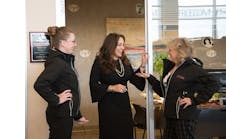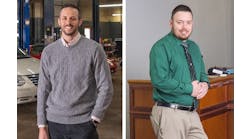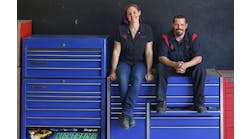The bubble of Influence—when an individual has a limited view of something based on the segregated points of influence of where they receive their information. For instance, someone who solely receives news from their own political party, will only continue to have their thoughts confirmed, never challenged or expanded.
So, how does “the bubble of influence” relate to the auto industry? Perception.
Customers’ perception of the industry is influenced by their few experiences they have within it, as well as what they hear from within their social circles. And as most would agree, the perception of the industry generally isn’t the most positive.
“Technicians are internal customers, if we are looking at the industry and saying ‘what’s the image of this industry’, and we have a technician shortage, that’s a pretty good indicator,” says Lucas Underwood, owner of L&N Performance Auto Repair in Blowing Rock, N.C.
Ratchet+Wrench continues to dive into the depths of this image problem by isolating specific industry misconceptions. But, this leaves the question of finding the best way to reverse said negative stereotypes. As well as ways shops can increase the public's trust to gain business and ultimately, rid the negative image.
In comes a new “bubble”—a social group made specifically of shop owners, to discuss these issues and possible solutions.
The Facebook Group
Auto shops around the country (and world) are using social platforms to connect and discuss strategies to reverse the industry’s negative image. One of the largest social platforms comes in the form of Facebook groups. Many Facebook groups for auto shop owners are on the site, and one of the largest in numbers is the Auto Shop Owners Group. Scott Pelava, owner of Lonsdale Auto Works in Lonsdale, Minn., created the network around four years ago.
The following are discussion points from thousands of shop owners in these groups, and their ideas on ways your shop can add to the movement of reversing the industry’s negative image, especially for millenials.
“If we can maintain the evolution to the industry, and handle the public's perception of the industry, they [customers] can begin to understand what their dollar is being spent on,” Pelava says.
1.Eliminate Competitiveness.
Trust. It’s one of the biggest words that comes up when discussing the industry’s image.
The public seems to continue to hold this negative perception of distrust, which then bleeds over into almost all other industry stereotypes. Pelava may have a reason as to why this misconception continues to grow.
It comes down to the undermining of other businesses, he says.
“Not treating every shop as competition or like the enemy, is a big thing,” says Pelava.
He gives the example of being a patient going to the doctor:
“If you’ve ever gone into the doctor and asked for a second opinion, and they come back with a different diagnosis, they would say, ‘I can see where they got this conclusion’. They would never say, ‘That guy was a quack and didn't know what he was talking about,’” says Pelava.
This sometimes happens between competing auto shops. A customer goes to a shop to figure out what is going on with their car and then goes to a different shop for a second opinion, only for the second to tear down the opinion and work of the previous.
“If you talk to any other professional industry, that's not happening. Those industries are lifting each other up.” says Lucas Underwood, shop owner and group monitor on Auto Shop Owners Group.
This puts the customer in an uncomfortable position and has them questioning the legitimacy of both places.
“Everyone is quick to criticize the other guy, and that has done nothing but create a level distrust amongst the public,” Pelava says.
“If you have another business that has done something incorrectly, reach out to that business first, and try and come up with a resolution. Try and let them know whats going on and coach them in the direction to solve the problem” says Underwood.
This has been discussed on the Facebook discussion page on Auto Shop Owners Group (ASOG), but sometimes, these groups themselves almost act as part of the solution.
“As an industry we are still fighting the stigma of, ‘I can do it cheaper’, or, ‘so-and-so charged too much’,” says Andrew Lee, owner of AutoMotion Complete Car Care in Buchanan, Mich., and ASOG monitor.
Shop owners feel less aversion to helping fellow shop owners on the Facebook group because they are in different towns in a completely separate states, miles away and aren't considered direct competition, Lee says. But he sees this mindset begin to shift the mentality of how shops interact with each other as a whole.
“If I can be like that with someone a couple states away, why cant I treat the guy across town the same way,” Lee says.
That switch can eliminate some competitiveness and secure more trust in the industry for customers.
“If you look at what’s driving by your shop, there’s plenty of potential, there is no reason we need to look at it from this competitive standpoint,” explains Underwood.
2. Promote Consistency.
In addition to these Facebook shop owner groups, there is also normally a moderator group. For ASOG, this is where Pelava, Lee, Underwood, the other shop owners working to maintain the page discuss ways to best use the platform to spark industry change.
“There’s a lot of debate that goes on about public perception,” says Pelava.
This comes from the competing mindset of some shop owners running their business the way they want to because it’s their own, and others wanting shops owners to all follow similar practices.
Pelava is a part of the latter group.
“We try to promote some consistency industry wide, and that in itself changes the customer perception,” he says.
“We have some great organizations that are moving in that direction, your ASA chapters, your independent garage associations are trying to facilitate consistency,” says Underwood. “If we can begin to teach some more standards, and standard operations across the board, I think it will definitely improve the image of the industry today”.
Scott Pelava says that a majority of that consistency comes with shared ideas of professionalism. When employees are up front and dealing with customers, that gives a face to the industry. If the individual isn't the greatest salesperson or not great with the customer, they can continue to add to the negative industry stereotypes, he says.
“We’re trying to get the point across that we have to maintain professionalism,” Pelava says.
He explains that being a good salesperson for a specific business, in turn makes them a good salesman for the industry as a whole. That can eliminate a lot of the mixed messages and negative stereotypes that continue to be fostered.
“It is going to be a long drawn out process to get there, it’s not something that’s going to happen overnight. But we definitely need to have some standards and bring some standard process and procedure to everything industry does,” Underwood says.
3. Take Advantage of Social Media.
Being a good salesperson for your business, and the industry as a whole, continues outside of your physical shop. The use of marketing and social media stands in as a representation of the auto industry, especially for younger generations. To change the minds of future customers you need to speak to them in their language, says Pelava.
The best way to reach young customers this day and age is through the generation’s biggest and most popular form of communication, social media. The tone and intentions of a company are easily showcased through how they present and interact online. But without taking advantage of the platform, or by not having a presence in general, a large avenue is lost. Social media is the ideal way to reach younger audiences to be potential customers, and to change and shape their view of the industry.
“Some shops think they don’t need social media, they think just word-of-mouth works well enough. Social media is a different word of mouth,” Pelava says.
A lot of the owners hesitant to the social media switch seem to be older shop owners near retirement, says Underwood. They are happy with what they are doing now and don’t want to create an online presence. But that decision classifies out an entire generation, and excludes them as new customers. Making social media an essential to gaining younger customers.
Andrew Lee actually used the ASOG community to help with his own shop’s social media and marketing. He gave admin credentials to a fellow group member to take over his marketing and social media accounts.
Once a shop has created their social media presence, Pelava suggests posting some informational pieces on Facebook or other platforms. This does two things: creates trust, and engages potential younger customers.
4. Educate Potential Customers.
Education can go beyond the screen, and give an even more hands-on approach to letting customers in on a little bit of the industry. The knowledge and kindness extended from the shop to the community can spark change and trust in potential customers.
The trust comes from debunking the stereotype that the auto repair industry tries to keep customers in the dark, that repair shops aren't trying to perform work on their car that they could have done themselves. These educational classes, and social media posts, remove the mythicality of auto care, Pelava says.
He does this by offering women car clinics. His first one lasted three hours and included roughly 20 women.
“That in itself was huge,” Pelava says.
He covered the basics and beyond of auto care, including some classroom time and some time in the shop. The education gave the car clinic participants knowledge of what they can look out for on their own and when they should bring their car in to the professionals.
Pelava will give advice and empower customers. This is so customers don't feel like the industry is trying to trick them and add to the misconception of distrust that surrounds the auto industry.
Lucas Underwood strives to educate each customer that comes into his shop.
“It helps create a culture where were trying to take care of the safety issue, trying to educate them about why those safety issues are important, and we’re showing them what their car genuinely needs to meet their needs,” Underwood explains.
5. Ramp up Your Waiting Room and Reception Area.
When inside a shop, customers spend the most time inside the waiting room and reception area. This relationship between customer and space can greatly attribute to how they subconsciously view your shop, and the industry as a whole, Pelava says. The waiting room and reception area become almost a physical representation of the industry, especially for millennials who may not have had many other auto shop experiences.
A shop’s waiting room is dirty and outdated? The industry must certainly also be dirty and outdated.
Pelava, along with other Auto Shop Owner Group’s moderators decided to ask members to post photos of their waiting rooms to a thread on the Facebook page, and what they got was, well, everything.
From pristine “dealership alternatives” to dull rooms that looked to not have been updated since the 1950s, the Facebook group members saw it all.
“Some shops have the mindset that their shop should be a reflection of themselves. They like race cars, so the waiting room is full of them. But the customers don’t care about race cars,” Pelava says, “[they] just want [their] car fixed.”
Millennials want to be catered to, Pelava says, and a waiting room filled with car memorabilia won’t create that feeling.
On the flip side, he saw shops that seem to have hit a waiting room homerun on accommodating the needs of younger customers. Some additions these waiting rooms have added include a simple snack station or a coffee machine, he says. Not only do these additives create a more comfortable and relaxing atmosphere to customers, but also quickly give the younger crowd the feeling of being catered to.
Although, not all shop owners agree that this is an important factor. Underwood describes his Blowing Rock shop as being unorganized and not a “top shop” when it comes to its image. He argues that consistency and taking care of your customer means more than it’s physical form to both the shop and the industry’s image.
Not all shop owners are going to agree with every image building tactic, but it’s important to break that bubble and discuss and implement change with others.
Above all, the industry’s image issue is a “human problem,” Lee says. He suggests approaching it with empathy with taking ownership to help to find solutions. Those practices will help debunk and rebuild.
Join the Discussion
The Auto Shop Owners Group on Facebook, and many others in the industry, are all discussing what can be done to create a shift in the misconceptions and stereotypes of the industry. Here is a list of more Facebook groups to join to take part in the discussion:
- Owners & Service Advisors of Auto Repair Shops
- Auto Shop Owners Encouraging Each Other
- Automotive Shop Owners Group (Modern Owners)
- Auto Repair Shop Owners
- Successful Shop Owners



